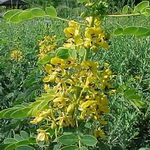| Common Name: |
Wild Senna |
| Botanical Name: |
Senna marilandica |
| Genus: |
Senna |
| Family Name: |
Caesalpiniaceae |
| Native Location: |
Midwest and SE USA |
| Cultivation: |
Well-drained soil in sun. Senna marilandica needs rich, moist, sandy oil. Pot-grown plants may be damaged by root mealy-bugs. |
| Propagation: |
By seed sown in spring at 18-24°C (64-75°F); by semi-ripe cuttings in summer. Prune to shape and remove dead or badly placed growths in early spring. |
| Harvest: |
Leaves are picked before and during flowering; pods are collected in autumn when ripe. Both are dried for use in infusions, powders, tablets, and tinctures. |
| Height: |
60cm-2m (2-6ft) |
| Width: |
15cm-1.2m (6in-4ft) |
| Hardiness: |
Z3-9 |
| Parts Used: |
Leaves, pods. |
| Properties: |
A laxative herb with a milder, slower effect than S. alexandrina. |
| Medicinal Uses: |
Internally for constipation. |
| Bibliography: |
Encyclopedia of Herbs ~ Deni Bown ~ Copyright © 1995, 2001, Doring Kindersley Limited ~ pp. 366-367 |

